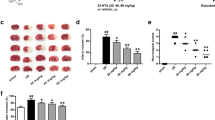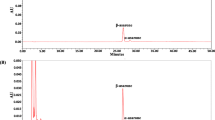Abstract
The fruit of Terminalia chebula Retz has been used as a traditional medicine in Asia and contains tannic acid, chebulagic acid, chebulinic acid and corilagin. Extract from T. chebula seeds (TCE) has various biological functions. We observed the neuroprotective effects of TCE against ischemic damage in the hippocampal C1 region (CA1) of the gerbil that had received oral administrations of TCE (100 mg/kg) once a day for 7 days before the induction of transient cerebral ischemia. In the TCE-treated ischemia group, neuronal neuclei (a marker for neurons)-positive neurons were distinctively abundant (62% of the sham group) in the CA1 4 days after ischemia-reperfusion (I-R) compared to those (12.2% of the sham group) in the vehicle-treated ischemia group. Four days after I-R TCE treatment markedly decreased the activation of astrocytes and microglia in the ischemic CA1 compared with the vehicle-treated ischemia group. In addition, immunoreactivities of Cu, Zn-superoxide dismutase (SOD1), Mn-superoxide dismutase (SOD2) and brain-derived neurotrophic factor (BDNF) in the CA1 of the TCE-treated ischemia group were much higher than those in the vehicle-ischemia group 4 days after I-R. Protein levels of SOD1, SOD2 and BDNF in the TCE-treated ischemia group were also much higher than those in the vehicle-ischemia group 4 days after I-R. These results indicate that the repeated supplement of TCE protected neurons from ischemic damage induced by transient cerebral ischemia by maintaining SODs and BDNF levels as well as decreasing glial activation.






Similar content being viewed by others
References
Kirino T (1994) Cerebral ischemia and neuronal death. No To Hattatsu 26:130–135
Lee CH, Yoo KY, Choi JH et al (2011) Cyclin D1 immunoreactivity changes in CA1 pyramidal neurons and dentate granule cells in the gerbil hippocampus after transient forebrain ischemia. Neurol Res 33:93–100
Chan PH (2001) Reactive oxygen radicals in signaling and damage in the ischemic brain. J Cereb Blood Flow Metab 21:2–14
Hwang IK, Eum WS, Yoo KY et al (2005) Copper chaperone for Cu, Zn-SOD supplement potentiates the Cu, Zn-SOD function of neuroprotective effects against ischemic neuronal damage in the gerbil hippocampus. Free Radic Biol Med 39:392–402
Beal MF (1999) Mitochondria, NO and neurodegeneration. Biochem Soc Symp 66:43–54
Yoo KY, Li H, Hwang IK et al (2010) Zizyphus attenuates ischemic damage in the gerbil hippocampus via its antioxidant effect. J Med Food 13:557–563
Aldarmaa J, Liu Z, Long J, Mo X, Ma J, Liu J (2010) Anti-convulsant effect and mechanism of Astragalus mongholicus extract in vitro and in vivo: protection against oxidative damage and mitochondrial dysfunction. Neurochem Res 35:33–41
de Oliveria DM, Barreto G, De Andrade DV et al (2009) Cytoprotective effect of Valeriana officinalis extract on an in vitro experimental model of Parkinson disease. Neurochem Res 34:215–220
Rajasankar S, Manivasagam T, Surendran S (2009) Ashwagandha leaf extract: a potential agent in treating oxidative damage and physiological abnormalities seen in a mouse model of Parkinson’s disease. Neurosci Lett 454:11–15
Luo Y (2001) Ginkgo biloba neuroprotection: therapeutic implications in Alzheimer’s disease. J Alzheimers Dis 3:401–407
Perry LM, Metzger J (1980) Medicinal plants of East and Southeast Asia: attributed properties and uses. MIT Press, Cambridge, pp 80–81
Gali HU, Perchellet EM, Klish DS, Johnson JM, Perchellet JP (1992) Hydrolyzable tannins: potent inhibitors of hydroperoxide production and tumor promotion in mouse skin treated with 12-O-tetradecanoylphorbol-13-acetate in vivo. Int J Cancer 51:425–432
Kuo ML, Lee KC, Lin JK (1992) Genotoxicities of nitropyrenes and their modulation by apigenin, tannic acid, ellagic acid and indole-3-carbinol in the Salmonella and CHO systems. Mutat Res 270:87–95
Sah NK, Kumar S, Subramanian M, Devasagayam TP (1995) Variation in the modulation of superoxide-induced single-strand breaks in plasmid pBR322 DNA by biological antioxidants. Biochem Mol Biol Int 35:291–296
Reddy DB, Reddanna P (2009) Chebulagic acid (CA) attenuates LPS-induced inflammation by suppressing NF-kappaB and MAPK activation in RAW 264.7 macrophages. Biochem Biophys Res Commun 381:112–117
Reddy DB, Reddy TC, Jyotsna G et al (2009) Chebulagic acid, a COX-LOX dual inhibitor isolated from the fruits of Terminalia chebula Retz., induces apoptosis in COLO-205 cell line. J Ethnopharmacol 124:506–512
Silva O, Ferreira E, Vaz Pato M, Caniça M, Gomes ET (2002) In vitro anti-Neisseria gonorrhoeae activity of Terminalia macroptera leaves. FEMS Microbiol Lett 211:203–206
Saleem A, Husheem M, Härkönen P, Pihlaja K (2002) Inhibition of cancer cell growth by crude extract and the phenolics of Terminalia chebula retz. fruit. J Ethnopharmacol 81:327–336
Kinoshita S, Inoue Y, Nakama S, Ichiba T, Aniya Y (2007) Antioxidant and hepatoprotective actions of medicinal herb, Terminalia catappa L. from Okinawa Island and its tannin corilagin. Phytomedicine 14:755–762
Cheng JT, Lin TC, Hsu FL (1995) Antihypertensive effect of corilagin in the rat. Can J Physiol Pharmacol 73:1425–1429
Duan W, Yu Y, Zhang L (2005) Antiatherogenic effects of phyllanthus emblica associated with corilagin and its analogue. Yakugaku Zasshi 125:587–591
Zhao L, Zhang SL, Tao JY et al (2008) Preliminary exploration on anti-inflammatory mechanism of Corilagin (beta-1-O-galloyl-3, 6-(R)-hexahydroxydiphenoyl-d-glucose) in vitro. Int Immunopharmacol 8:1059–1064
Manyam BV (1999) Dementia in ayurveda. J Altern Complement Med 5:81–88
Misra R (1998) Modern drug development from traditional medicinal plants using radioligand receptor-binding assays. Med Res Rev 18:383–402
Mahesh R, Bhuvana S, Begum VM (2009) Effect of Terminalia chebula aqueous extract on oxidative stress and antioxidant status in the liver and kidney of young and aged rats. Cell Biochem Funct 27:358–363
Suchalatha S, Devi CS (2005) Protective effect of Terminalia chebula against lysosomal enzyme alterations in isoproterenol-induced cardiac damage in rats. Exp Clin Cardiol 10:91–95
Lee CH, Yoo KY, Choi JH et al (2010) Melatonin’s protective action against ischemic neuronal damage is associated with up-regulation of the MT2 melatonin receptor. J Neurosci Res 88:2630–2640
Nazam Ansari M, Bhandari U, Islam F, Tripathi CD (2008) Evaluation of antioxidant and neuroprotective effect of ethanolic extract of Embelia ribes Burm in focal cerebral ischemia/reperfusion-induced oxidative stress in rats. Fundam Clin Pharmacol 22:305–314
Ahn HC, Yoo KY, Hwang IK et al (2009) Ischemia-related changes in naive and mutant forms of ubiquitin and neuroprotective effects of ubiquitin in the hippocampus following experimental transient ischemic damage. Exp Neurol 220:120–132
Kirino T (1982) Delayed neuronal death in the gerbil hippocampus following ischemia. Brain Res 239:57–69
Dong Y, Benveniste EN (2001) Immune function of astrocytes. Glia 36:180–190
Hwang IK, Yoo KY, Kim DW et al (2006) Ionized calcium-binding adapter molecule 1 immunoreactive cells change in the gerbil hippocampal CA1 region after ischemia/reperfusion. Neurochem Res 31:957–965
Rogers J, Strohmeyer R, Kovelowski CJ, Li R (2002) Microglia and inflammatory mechanisms in the clearance of amyloid beta peptide. Glia 40:260–269
Naik GH, Priyadarsini KI, Naik DB, Gangabhagirathi R, Mohan H (2004) Studies on the aqueous extract of Terminalia chebula as a potent antioxidant and a probable radioprotector. Phytomedicine 11:530–538
Cheng HY, Lin TC, Yu KH, Yang CM, Lin CC (2003) Antioxidant and free radical scavenging activities of Terminalia chebula. Biol Pharm Bull 26:1331–1335
Fujimura M, Morita-Fujimura Y, Kawase M et al (1999) Manganese superoxide dismutase mediates the early release of mitochondrial cytochrome C and subsequent DNA fragmentation after permanent focal cerebral ischemia in mice. J Neurosci 19:3414–3422
Greenlund LJ, Deckwerth TL, Johnson EM Jr (1995) Superoxide dismutase delays neuronal apoptosis: a role for reactive oxygen species in programmed neuronal death. Neuron 14:303–315
Sugawara T, Noshita N, Lewen A et al (2002) Overexpression of copper/zinc superoxide dismutase in transgenic rats protects vulnerable neurons against ischemic damage by blocking the mitochondrial pathway of caspase activation. J Neurosci 22:209–217
Ferrer I, Ballabriga J, Marti E, Perez E, Alberch J, Arenas E (1998) BDNF up-regulates TrkB protein and prevents the death of CA1 neurons following transient forebrain ischemia. Brain Pathol 8:253–261
Larsson E, Nanobashvili A, Kokaia Z, Lindvall O (1999) Evidence for neuroprotective effects of endogenous brain-derived neurotrophic factor after global forebrain ischemia in rats. J Cereb Blood Flow Metab 19:1220–1228
Shirakura M, Inoue M, Fujikawa S et al (2004) Postischemic administration of Sendai virus vector carrying neurotrophic factor genes prevents delayed neuronal death in gerbils. Gene Ther 11:784–790
Cheng B, Mattson MP (1994) NT-3 and BDNF protect CNS neurons against metabolic/excitotoxic insults. Brain Res 640:56–67
Gardiner J, Barton D, Overall R, Marc J (2009) Neurotrophic support and oxidative stress: converging effects in the normal and diseased nervous system. Neuroscientist 15:47–61
Acknowledgments
The authors would like to thank Mr. Sung Auk Lee for his technical help in this study. This research was supported by a grant (2010K000823) from Brain Research Center of the 21st Century Frontier Research Program funded by the Ministry of Education, Science and Technology, the Republic of Korea, and by the Regional Core Research Program funded by the Korea Ministry of Education, Science and Technology (Medical & Bio-material Research Center).
Author information
Authors and Affiliations
Corresponding authors
Additional information
Joon Ha Park and Han Seung Joo contributed equally to this article.
Rights and permissions
About this article
Cite this article
Park, J.H., Joo, H.S., Yoo, KY. et al. Extract from Terminalia chebula Seeds Protect Against Experimental Ischemic Neuronal Damage Via Maintaining SODs and BDNF Levels. Neurochem Res 36, 2043–2050 (2011). https://doi.org/10.1007/s11064-011-0528-9
Accepted:
Published:
Issue Date:
DOI: https://doi.org/10.1007/s11064-011-0528-9




